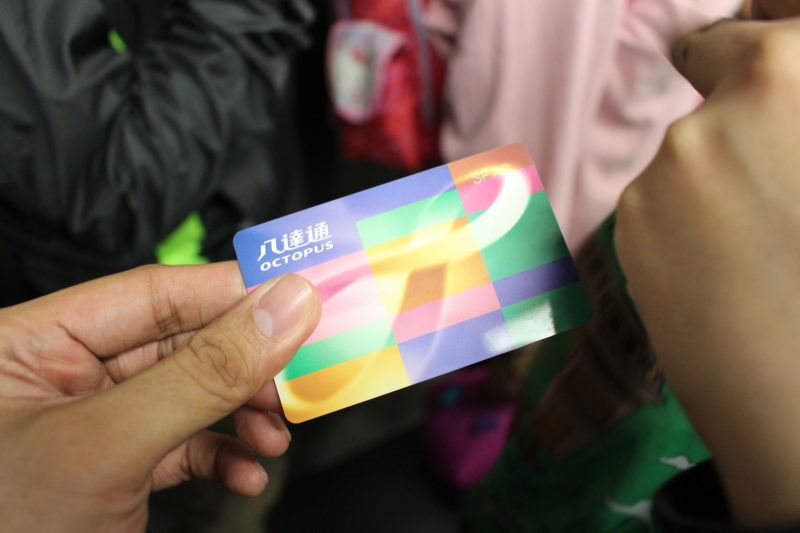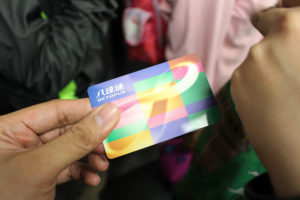
In 1997, after years of planning and coordination between various public transport bodies, the Hong Kong government unveiled the Octopus card, a contactless card system allowing for easier collection of fares for the city’s trains and buses, It was popular from the beginning, fueled in part by fears of a coin shortage in the city in the immediate aftermath of the handover from the United Kingdom to China.

Fast forward twenty years, and the Octopus card is a ubiquitous presence in the city. It is no longer used just for public transport: at the beginning major convenience stores and supermarkets adopted the standard, with some chains using it as a customer rewards scheme as well. Some establishments even require the use of an Octopus card for tenants to enter residential and office complexes.
I have been flying to Hong Kong once a year for the past four years, but only this time did I get myself an Octopus card. My sister was with me for a vacation, and we had a weekend to ourselves. (I usually just walk from my hotel to Causeway Bay.) With talk of the cashless economy starting to make headway in the Philippines, I decided to test the Octopus system to see how much better it is.
All right, it’s nothing really new to me – or to us, for that matter. Upon the suggestion of friends there I have tried similar systems in Seoul and in Taipei, and indeed it is convenient just tapping a card when you’re out for a quick purchase at the convenience store. We already have something similar in Manila, even, with the Beep card being accepted at some convenience stores. But in Hong Kong, it really is everywhere. You can even pay for your furniture at Ikea with it. At least having your money in one card makes for a slight reduction in the weight you carry, especially if you have to bring a disassembled sofa around.
But the maturity of Hong Kong’s cashless economy means you can really go out and about in the city without having to bring a wallet. (Apart from cards, you can buy Octopus-powered ornaments, meaning you can get yourself a Gudetama keychain through which you can pay for everything. And, of course, there is now an app allowing for payments through mobile phones.) My sister and I took a train from Wanchai to Mongkok; having the card means we could get to a train faster, and cheaper, as there are preferential Octopus rates. I could’ve bought my girlfriend a lipstick with my Octopus card, but the store was crowded and I wasn’t sure what to get.
However, it was at a McDonald’s branch two train stations away where I understood the strengths of the cashless economy. You make your order through a touch-screen kiosk – Hokkaido salmon burger, large fries and Coke, chocolate pie – and pay through Octopus, or the many other cashless payment schemes in the city like contactless debit cards and phone-based solutions from Apple, Google and Alibaba. Or you can pay for it in cash, but you’ll have to fall in line a second time. Once all that’s done, wait for your number to come up and get your meal at the claim counter. It all feels cold, actually, the lack of human interaction.
And then it’s a train to Tsim Sha Tsui, and then a ferry back to Wanchai – also powered by Octopus – before we returned to our hotel, to rest a bit before heading to Causeway Bay, this time by tram, also powered by Octopus. There I finally got lipstick for my girlfriend. I paid for it in cash. I did not have enough credit in my card.
The people behind Octopus would say they are falling behind. The rise of platforms like Alipay means Octopus has to work more to adapt to the needs of its patrons, but as the official contactless payment scheme for Hong Kong’s public transport system, it’s not going away soon. Meanwhile you’ll see the Octopus logo in many more places – restaurants, parking meters, even shoe shiners at the Central district.
This, more or less, is what’s going to happen in the Philippines. We’ve long had cashless payment schemes, but being competitors they have not made an effort to be universal. The Beep card could have been it, but its use is limited to a few merchants. The recent relaunch of Globe GCash – with the support of Alibaba – could change all that: I have already seen those QR codes at some shops within Ayala malls. Just last week, SM and Robinson’s department stores have announced that they will accept GCash, too.
More things are stopping us, though, and that’s cultural: a majority of Filipinos have no access to physical banks, while others just don’t trust them with their money. And then there’s our limited physical and virtual infrastructure to support a cashless economy. This can mean transparency and speed for supply chain’s very important last mile – but we will all still worry about hackers.
SCMAP’s 2018 BOD: Christine Pardiñas of Rustan Supercenters has been named SCMAP president-elect for 2018, meaning she will assume the organization’s top post in 2019 to 2020 – the first from the retail sector to do so. Nestor Felicio from Unilab will continue his term as president this year. Dina Pilapil from LF Logistics is secretary; Clarisse Castillo from Johnson & Johnson, treasurer; and Arnel Gamboa from National Bookstore, auditor. Serving as directors next year are Angie Santor, Nestlé; Carlo Curay, XVC Logistics; German Martizano, Unilever; Mack Comandante, Zuellig Pharma; and Tina Alvarezs, Procter & Gamble.
Henrik Batallones is the marketing and communications executive of SCMAP. A former board director, he is also editor-in-chief of the organization’s official publication, Supply Chain Philippines. More information about SCMAP is available at scmap.org.





